

After the Transplant - Phalaenopsis |
||
| Phalaenopsis
usually adapt to hydroponics without incident. Plants with
healthy
roots transfer easily. Put your plant in a good growing area
and let the Hydroponic System go to work for you! If your plant had damaged roots however, a little "tender loving care" might be needed. We'll show you what to do in the "Possible Trouble" section below. |
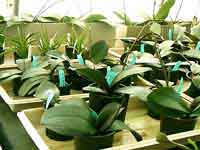 Phalaenopsis
transplants
in our
greenhouse. (We use Grow Trays instead of Outer Pots and
Gauges.)
|
|
|
Plant Care - Phalaenopsis Light: Bright light with a little morning or afternoon sun is ideal. Temp: Phalaenopsis like warm temps 70-85 degrees during the day an d 60-70 degrees at night is best. (A cold windowsill is not the best place for new transplants.) Water: Water to 1/4 - 1/2 on gauge. Then wait until system is completely dry before rewatering. |
|||||||
After the Transplant - What to Look For
| In
most cases,
newly transplanted Phals adapt to our system without incident. Give
your plant bright light with a little morning or afternoon sun and let
the Hydroponic System do the rest! As moisture is "pulled up" from the bottom by the LECA pebbles, fresh air circulates around the roots. The perfect environment for new root growth! In a few weeks, watch for new roots emerging at the base of the plant. Healthy new roots mean strong plants. And strong plants produce beautiful blooms. Another sign of growth is a new leaf developing at the top. Your new plant is healthy and happy! |
|||
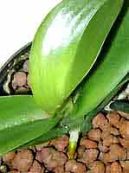 New roots on Phalaenopsis. Healthy roots are light grey in color with light green growing tips. |
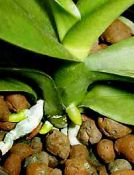 Don't worry if new roots are growing along the top of the pebbles - they'll find their way down. In fact, new roots are growing down inside the pot at the same time! |
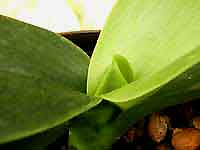 Another
sign to look for is a new leaf emerging at the crown.
|
|
| Don't get concerned if some of the older leaves turn yellow. One or two yellow leaves are normal. Remove all discolored leaves so your new transplant will concentrate all its energy on new growth. | |||
After the Transplant - Possible Trouble
| If you
found rotted and
mushy roots when transplanting, your plant wasn't happy in its
old
pot. The roots where suffocating as the potting materials
decomposed. Expect some
wilted leaves at first. Wilted Leaves Wilted, wrinkled leaves means they're dehydrated. If your plant isn't absorbing water (at the roots) and sending it up to the leaves, they dry out and become limp and wrinkled. |
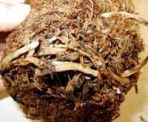 Decaying
Phalaenopsis
roots. Did your old roots look like this?
|
||
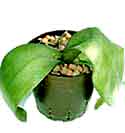 New
transplant with droopy leaves.
|
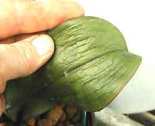 Dehydrated
leaves - the roots aren't sending up any moisture.
|
 Give the roots a boost with KLN Rooting Solution |
|
Wilting leaves! Your first instinct is to more water. Stop! That's
exactly
the wrong response!
The roots have shut down and can't absorb moisture. Inactive roots need more air, not more water. Stop watering! To make sure air is moving freely around the LECA pebbles, dump out all the water. Then, wait several days before rewatering. After several days, rewater only 1/4 on gauge. Allow enough time to for system to dry out completey before rewatering. To make sure the system is completely dry, use the indicator as handle and lift inner pot. Check bottom for moisture. When bottom is dry, rewater. Allowing the system to dry out between waterings promotes maximum air flow and encourages new root growth. |
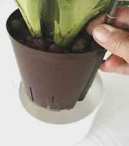 Make sure system is completely dry
before rewatering. Using water gauge as a handle, lift inner pot and
check bottom for dryness.
|
||
| If the problem persists, repotting (again) might be necessary. Gently remove the plant from its pot to see what's going on. | |||
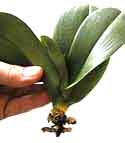 Trim away mushy roots (again). Your plant might even look like this when you're through. |
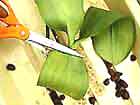 Next, trim away wrinkled leaves so plant will concentarte on new growth. Old leaves won't perk up again anyway. Don't remove all the leaves - keep at least 2 on the plant. |
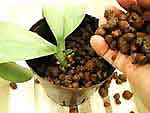 Repot plant again. Try using a smaller pot so the system dries out faster- getting more air to the roots. |
|
Change the watering
routine.
Don't
allow
any standing water at the base for several
weeks. The new watering routine will be:
Struggling plants take 4-6 weeks to respond. When it looks like the plant is recovering (nothing bad happens), return to your regular watering routine. Apply nutrients at 1/2 strength. Otherwise, continue watering with this process until plant recovers (or until you decide to give up and send the poor thing to "Plant Heaven"). Store the KLN solution in a cool spot. (Refigerator is a good idea in the summer.) Mature plants enjoy a KLN watering every couple of months too! |
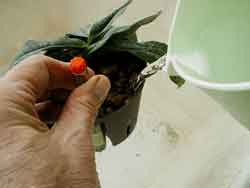 Slowly pour KLN solution through pebbles at sink. Then return plant to outer pot. |
||
 KLN Rooting Solution |
|||

